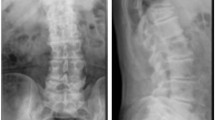Abstract
Background
Osteonecrosis with progressive collapse and segmental kyphosis can lead to intersegmental instability in some osteoporotic vertebral compression fractures (OVCFs). These conditions are known as Kümmell’s disease and often require anterior column reconstruction in elderly patients.
Methods
We attempted anterior column reconstruction by percutaneous transpedicular intracorporeal cage grafting (PTICG) with short-segment pedicle screw fixation and described the steps, with discussions on the surgical indications and pros and cons.
Conclusion
PTICG is expected to be an alternative to vertebral anterior column reconstruction, which can preserve the thoracolumbar posterior arch and paravertebral musculature.


Similar content being viewed by others
References
Zindrick MR, Wiltse LL, Doornik A, Widell EH, Knight GW, Patwardhan AG, Thomas JC, Rothman SL, Fields BT (1987) Analysis of the morphometric characteristics of the thoracic and lumbar pedicles. Spine 12:160–166
Lee J, Song KS (2020) Transpedicular intravertebral cage augmentation in a patient with neurologic deficits after severely collapsed kummel disease: minimum 2-year follow-up. World Neurosurg 135:146–155
Lee SH, Jain V, Lee SH, Baek OK, Moon KH (2018) Transpedicular intrabody cage insertion with posterior spine stabilization in Kümmell disease: report of 2 cases. World Neurosurg 116:236–240
Ma Y, Li X, Dong J (2012) Is it useful to apply transpedicular intracorporeal bone grafting to unstable thoracolumbar fractures? A systematic review. Acta Neurochir 154:2205–2213
Zhu Y, Zhang Z, Jiang W, Su K, Wang Z, Wang C, Wang C, Wang Q (2021) Therapeutic efficacy of transpedicular impaction bone grafting with long segmental posterior instrumentation in Stage III Kümmell disease. Spine 46:907–914
Misenhimer GR, Peek RD, Wiltse LL, Rothman SL, Widell EH Jr (1989) Anatomic analysis of pedicle cortical and cancellous diameter as related to screw size. Spine 14:367–372
Takeshita K, Maruyama T, Chikuda H, Shoda N, Seichi A, Ono T, Nakamura K (2009) Diameter, length, and direction of pedicle screws for scoliotic spine: analysis by multiplanar reconstruction of computed tomography. Spine 34:798–803
Heo DH, Cho YJ (2011) Segmental artery injury following percutaneous vertebroplasty using extrapedicular approach. J Korean Neurosurg Soc 49:131–133
Yeh WL, Su CY, Chang CW, Chen CH, Fu TS, Chen LH, Lin TY (2017) Surgical outcome of atypical subtrochanteric and femoral fracture related to bisphosphonates use in osteoporotic patients with or without teriparatide treatment. BMC Musculoskelet Disord 18:527
Kim YC, Kim YH, Ha KY (2014) Pathomechanism of intravertebral clefts in osteoporotic compression fractures of the spine. Spine J 14:659–666
Acknowledgements
We would like to thank Editage (www.editage.co.kr) for the English language editing.
Author information
Authors and Affiliations
Contributions
HJ P and HB K contributed equally to this work. HBK and MSK contributed to the conception of the study. HJ P and MS K wrote the manuscript. KH Y and MS K reviewed the manuscript. All authors commented on the previous versions of the manuscript. All authors have read and approved the final manuscript.
Corresponding author
Ethics declarations
Ethics approval
This study protocol was approved by the Institutional Review Board (IRB FILE No: BMH 2022–01-030) and adhered to the guidelines of the Declaration of Helsinki.
Consent
Not applicable.
Competing interests
The authors declare no competing interests.
Additional information
Publisher's note
Springer Nature remains neutral with regard to jurisdictional claims in published maps and institutional affiliations.
Key points
I. Kümmell’s disease often requires highly invasive anterior column reconstruction with vertebral corpectomy.
II. In the treatment of Kümmell’s disease, transpedicular intracorporeal cage grafting using the conventional posterior approach has been introduced as an alternative to vertebral corpectomy.
III. Implants with a size greater than 80% of the diameter of the pedicle are inserted through the transpedicular approach, which causes pedicle plastic deformation changes, such as expansion or fracture, with the inherent potential of neurologic symptoms.
IV. Conventional transpedicular intracorporeal cage graft surgery involves not only paravertebral muscle and ligamentous injury but also complications such as retroperitoneal hematoma or nerve root irritation caused by incomplete isthmic endosteal fracture around the pedicle.
V. The percutaneous transpedicular approach is a minimally invasive technique used in vertebroplasty or pedicle screw fixation.
VI. Using a tubular retractor system or mini-open approach, surgical visualization of the pedicle orifice for the transpedicular approach can be obtained.
VII. Through sequential taping up to 9.5 mm, it is possible to induce plastic deformation of the pedicle without fracture at the isthmic endosteal area of the pedicle, which can irritate the nerve root.
VIII. Through the sequentially trial of interbody cage, it can be created intravertebral cavity.
IX. It is expected that intracorporeal grafting of a titanium interbody cage with a demineralized bone matrix will not only provide rigid intravertebral stability but also induce bone remodeling.
X. Percutaneous transpedicular intracorporeal cage graft can be a minimally invasive alternative to conformity because the adjacent intervertebral discs are preserved, and the vertebral height can be guaranteed as the height of the interbody cage.
This article is part of the Topical Collection on Spine trauma
Rights and permissions
About this article
Cite this article
Park, HJ., Kim, HB., You, KH. et al. Percutaneous transpedicular intracorporeal cage grafting for Kümmell disease. Acta Neurochir 164, 1891–1894 (2022). https://doi.org/10.1007/s00701-022-05211-z
Received:
Accepted:
Published:
Issue Date:
DOI: https://doi.org/10.1007/s00701-022-05211-z




